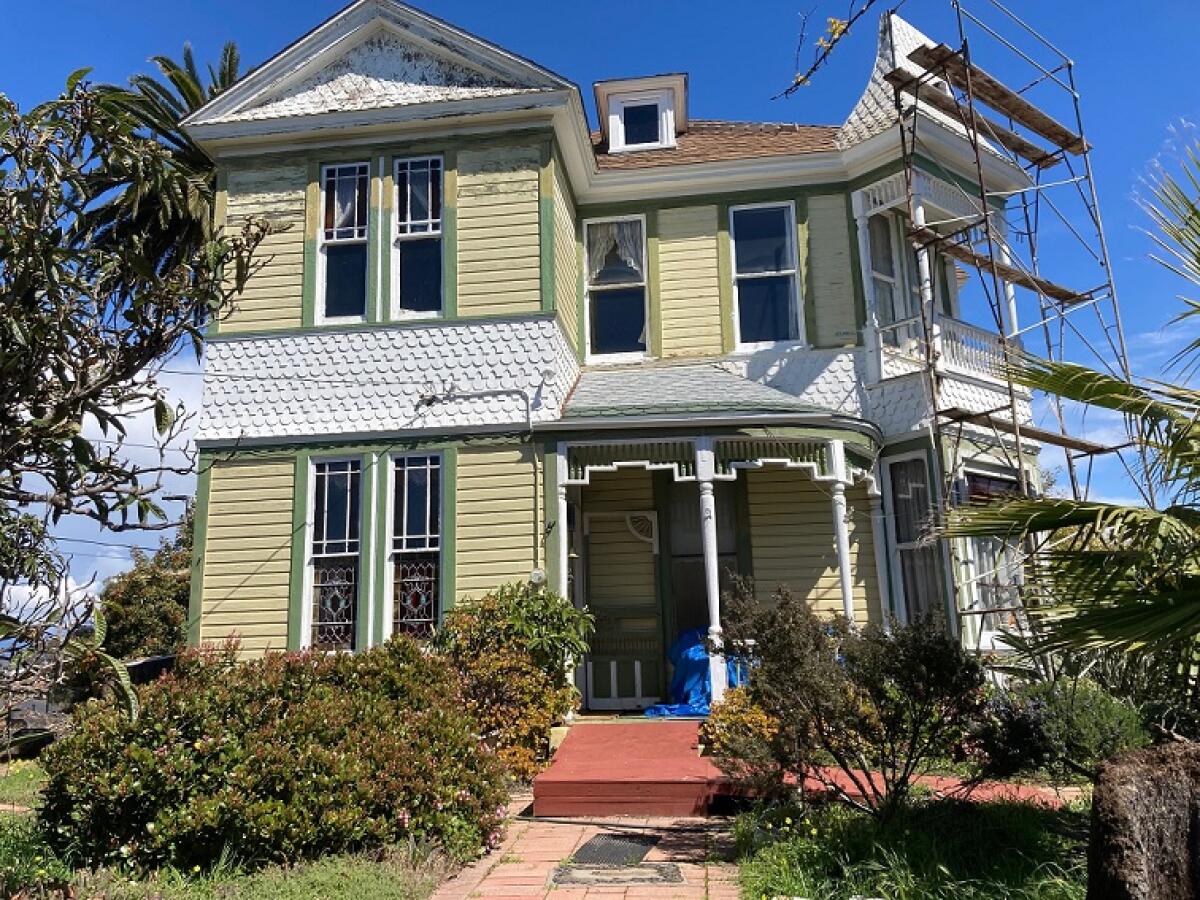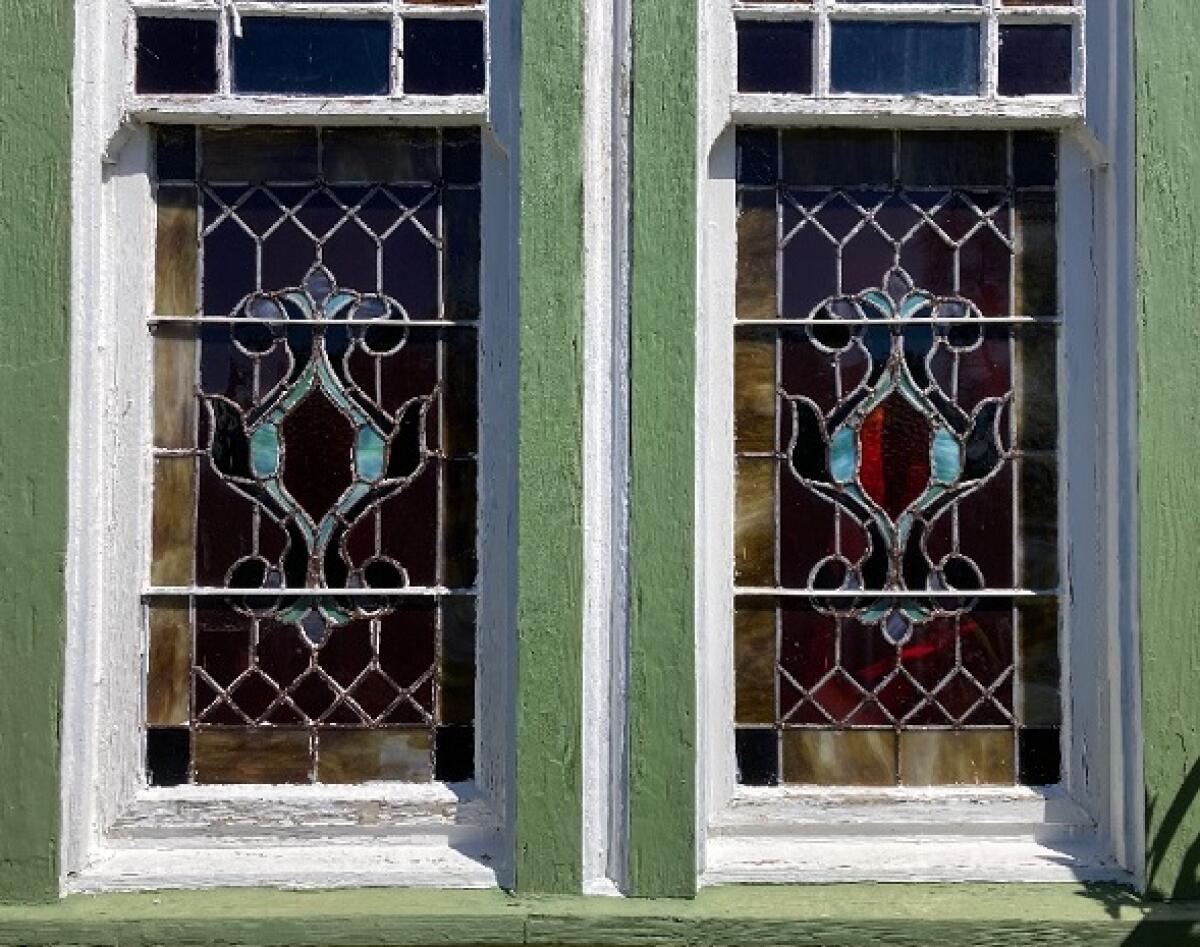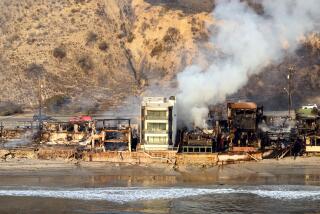Historic Carlsbad home built by Twin Inns builder could be lost. Family hopes it can be preserved

Family plans to sell 1887 Culver House, built to match Twin Inns
- Share via
CARSLBAD — The owners of a Queen Anne architectural gem in Carlsbad have appealed to the city in hopes of saving the historic house from the wrecking ball.
“The home was built by Alonzo Jackson Culver, who also built the Twin Inns,” states a letter from Rebecca Holbert and Paul Abodeely, two of the eight family members who inherited the property.
The Twin Inns were mirror-image Queen Anne-style mansions built in the 1880s on what is today Carlsbad Boulevard. In the early 1900s, they were restaurants famous for their chicken dinners among coastal travelers.
One of the twins, known as the Wadsworth mansion, was torn down in 1950. The other most recently was occupied by the Land & Water Co. restaurant, which closed in October 2019, but the building remains part of the Village Faire shopping center at the corner of Carlsbad Boulevard and Carlsbad Village Drive.
“Leftover lumber from the Twin Inns was used to build this sister home,” said Holbert and Abodeely, whose great-uncle Gerald Capp purchased the Culver House on one acre at the corner of Highland Drive and Oak Avenue in 1969.
Originally, the house was on 30 acres and had numerous outbuildings, including a blacksmith shop and a well house. It was built using pine from Julian, wooden nails, limestone, rock and sand, according to news stories.
Capp lived in the Culver House until his recent death. He installed an electrical system, repaired the stained glass windows, had plumbing installed for an indoor bathroom to replace the outhouse, and planted many of the Torrey pines, fruit trees and cacti that still grow on the property.
Also known as the Culver-Myers-Capp House, it is one of 19 properties that the City Council designated as sites of historic interest in 1986. The artist Gertrude Myers, considered the “Grandma Moses” of Carlsbad, lived there from 1936 until her death in 1965.
Without an occupant in recent years, the two-story building has fallen into disrepair, which the family hopes could be resolved by new owners.
“The reality is that the house will likely need to be sold and the proceeds divided,” the letter states. “We do not want this house to be torn down and the land divided. We are writing in the hopes that the city ... might be able to purchase the house and land in order to preserve it as a historic landmark and park for the enjoyment of the people of Carlsbad.”
The Carlsbad Historic Preservation Commission reviewed the family’s request at its March 8 meeting and agreed to ask the City Council to consider ways the property might be preserved.
“I’m not saying the city should buy it, necessarily,” said Commissioner Lauri Boone. “But there has to be some way to preserve this unique property and its history. There is an estate house, a carriage house and a second lot with old cars on it. There are so many creative ways this can be worked out.”
The Mills Act Program is one tool available, said Carlsbad Planning Commissioner Alicia Lafferty, an alternate member of the Historic Preservation Commission.
The program is an economic incentive provided by the state with oversight by the city for the restoration of qualified historic buildings by private property owners.
“This is a local historic resource ... a really important piece of architecture ... fast being lost,” Lafferty said.

One commissioner, Anne Estes, said she had recently visited the property and questioned the value of preserving it.
“The conditions there are just squalid,” Estes said, adding that she saw a broken door, rooms “jammed with stuff” and vandalism.
“It’s a huge problem in terms of safety,” she said. “There are surely dozens of code violations. The pretty things are there, but they haven’t been cared for.”
Boone agreed that the house needs work but said it’s a worthy project for the city.
Carlsbad has preserved other residences, including the Magee House, an 1887 Craftsman-style residence now in a park on Beech Street near Carlsbad Boulevard. Boone said that building also was in poor condition when the city acquired it in 1974.
“The same was true of Leo Carrillo’s ranch,” which is now a city historic park, Boone said. “It was so vandalized that the city had to hire a caretaker to live on the site to keep it from being destroyed.”
Today, the popular old Hollywood actor’s ranch hosts weddings, tours, art shows and community events.
More recently, the city worked with a developer and the community to create a park on the site of the long-abandoned Buena Vista Reservoir. The small, rectangular reservoir was built in 1918 on a ridge near Highland Drive to supply water to the area’s farming community.
“The community came forward to preserve the reservoir because of its historic significance,” Boone said. “There could be a creative way that the city works with whoever buys the Culver House property.”
Developers often are required to do mitigation projects, she said, and perhaps restoration of the house could be a condition of subdividing the property.
Diehl writes for the San Diego Union-Tribune.
More to Read
Sign up for Essential California
The most important California stories and recommendations in your inbox every morning.
You may occasionally receive promotional content from the Los Angeles Times.










